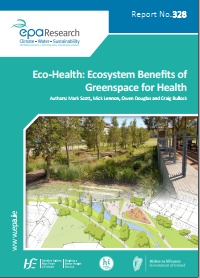Research 328: Eco-Health: Ecosystem Benefits of Greenspace for Health
Authors: Mark Scott, Mick Lennon, Owen Douglas and Craig Bullock
Summary:
This project advances the perspective that accessible and well-designed green spaces are essential infrastructure that is fundamental to the health and well-being of thriving and inclusive communities. There is a scientific consensus that green space provides multiple benefits for enhancing health and well-being, and these benefits provided by green space are increasingly recognised in policy at international, national and local levels.
Published: 2020
ISBN: 978-1-84095-920-8
Pages: 163
Filesize: 9,546 KB
Format: pdf
Download
Project Highlights
Watch the Eco-Health project highlights video
Identifying Pressures
The Eco-Health project advances the perspective that accessible and well-designed green spaces are essential infrastructure, fundamental to the health and wellbeing of thriving and inclusive communities. There is a scientific consensus that well-designed green space provides multiple benefits for enhancing health and well-being. Enhancing green space provision, access and design:
- Promotes physical activity through creating spaces for play, recreation, walking and cycling within a safe environment.
- Enhances mental well-being through creating urban refuges (from busy streets, traffic, noise) and providing a restorative environment through increased contact with nature.
- Enhances social interaction through providing opportunities for social contact, public places and community-building activities.
- Reduces environmental risks from pollution by mitigating air pollution and noise pollution through urban greening.
- Mitigates environmental risks from extreme weather through countering the urban heat island effect and acting as a “sponge” within the context of extreme rainfall or surface flooding. Both warmer and wetter weather are anticipated as impacts of climate change in Ireland; thus, future-proofing Irish urban areas against further risks is crucial.
Informing Policy
The Eco-Health project seeks to inform public health and spatial planning policy and the important interlinkages between environmental quality and health and well-being. Healthy Ireland (2013) embraces the shift from a health services focus and treating ill health towards a “whole-systems approach” to health and well-being. This approach recognises that positive health outcomes not only are determined by inherited individual characteristics, but also are influenced by contextual factors, including the social and environmental determinants of health. From the perspective of spatial planning, the concept of healthy places is increasingly espoused internationally and nationally. By enhancing the provision and design of green spaces, local authorities and public agencies can contribute towards key objectives within the National Planning Framework (2018) relating to healthy communities, compact growth and sustainable land use management.
However, although such policy guidance clearly supports an emphasis on green space provision for population health and well-being, it does not provide detailed guidance for planning and design policy in terms of the specific attributes required to tackle lifestyle illnesses in multiple cohorts.
Developing Solutions
Key design principles to maximise green spaces as health-promoting environments include:
- Accessible spaces with good links (pedestrian and cycleways) to nearby neighbourhoods.
- A networked approach: emphasising green infrastructure networks (rather than isolated parks) can provide new opportunities for connecting existing and new green spaces and creating new linkages between urban and rural areas.
- Inclusive in design, catering for local needs from young to old and all physical abilities. Green spaces that are designed to support very specific functions tend to attract limited groups of users.
- Well managed and maintained spaces, creating a high-quality environment: poorly managed spaces or vandalism prompt negative perceptions among potential users.
- Multifunctional uses: examples include spaces that encourage active mobility, physical activity and sports, relaxation and tranquillity, and opportunities for social exchange (e.g. that incorporate community gardens, encourage parkruns).
- Enhancement of urban greening through planting strategies that mitigate noise and air pollution and maximise local biodiversity gain and facilitate sustainable drainage (e.g. deciduous wooded and wildflower meadow areas).
- Creation of multisensory restorative environments that help mitigate the psychological stresses of modern living through the provision of “restive places for rejuvenation”.
https://www.epa.ie/media/archive/research/research-thumbnails/Research_328_thumbnail.png
